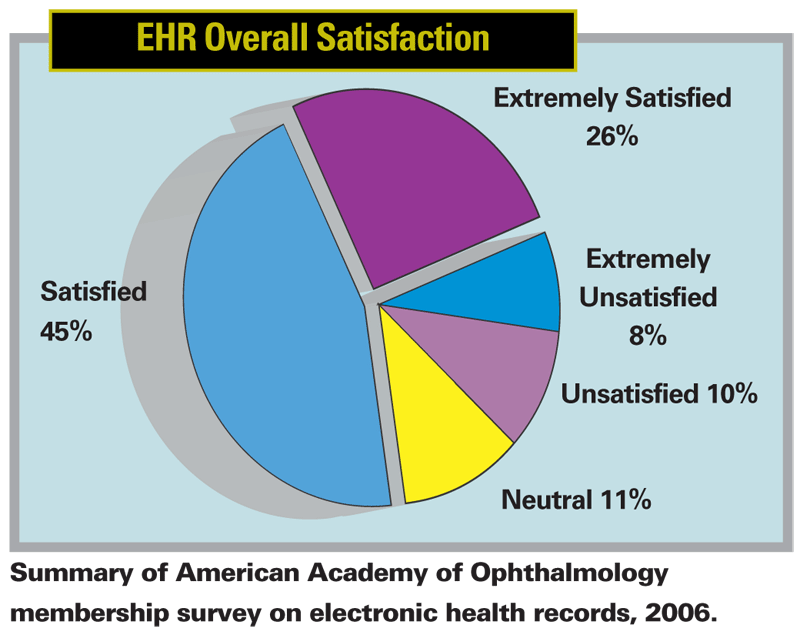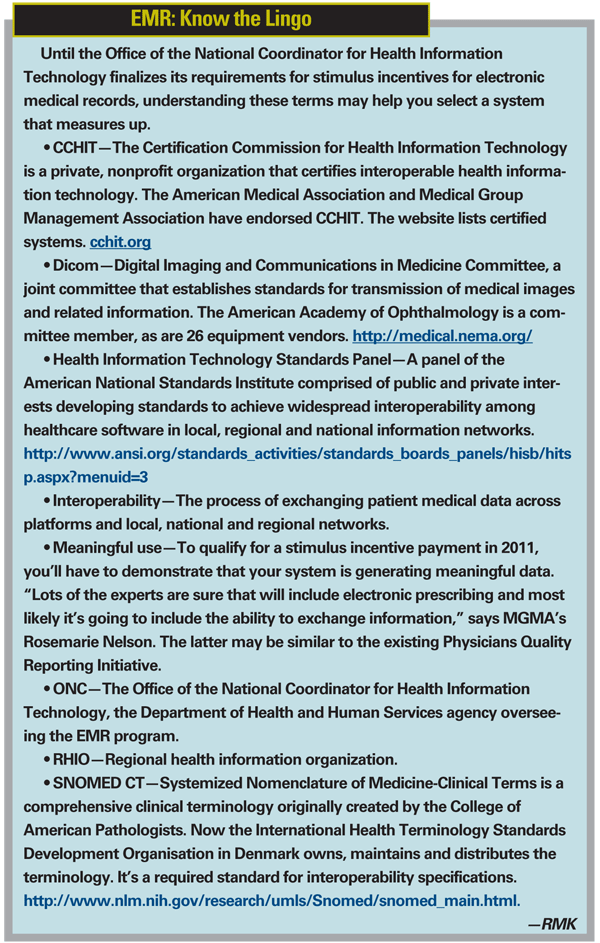Ophthalmologists David E. Silverstone and Dwayne Baharozian didn't need a federal incentive program to bring electronic medical records into their practices. The former made the move about 20 years ago, the latter in 2000. Neither would go back to paper.
Thanks to the federal economic stimulus President Obama signed in February, EMRs have taken center stage in the debate over reforming health care in the
Consider it a prelude. Someday the recession that necessitated the economic stimulus will end. However, medicine stands in the path of a medical tsunami that could hit full force just as the recessionary clouds lift. Five years from now you could be pining for the good old days of the recession of 2008 to 2010.
At the eye of this storm lies health-care reform itself. The movement toward universal coverage seems to be gaining unprecedented traction in
Other significant disturbances are already moving in. Besides the push for EMR, the Centers for Medicaid & Medicare Services is dangling incentives to lure physicians into e-prescribing. In 2013 CMS will introduce new ICD-10 codes, two years delayed from the original date.
Meanwhile, market-driven forces are gathering. Advances in telemedicine and point-of-care payment systems will dramatically change doctor-patient interactions. Genetic testing promises to give physicians more precise data about predictors of disease and treatments. In addition, the number of
Over the next few months, this series will analyze how these forces may impact your practice and provide insight into how to insure yourself against their wrath. Section 1 of your insurance policy against this maelstrom focuses on EMR.
Making Sense of the Stimulus
The economic stimulus for EMR, like any government incentive, comes with strings attached.
String 1: The government won't begin disbursing payments until 2011. Payments will be released through 2016, but 2015 is the last year to adopt EMR and qualify for payment the following year. "That's another reason why I tell people get in it now, get in it early," says Rosemarie Nelson, a consultant with the Medical Group Management Association Healthcare Consulting Group.
String 2: The provider must demonstrate "meaningful use" of an EMR system for a year. "What will a provider have to be doing to demonstrate 'meaningful use' of a system?" Ms. Nelson asks. For now, that answer is a moving target. Physicians who already have a full-functioning EMR will be at an advantage to have a full year of demonstrated results by 2011.
One indicator of "meaningful use" may involve the existing Commission for Healthcare Information Technology (CCHIT) certification for medical software. "I think we'd be naïve not to think that CCHIT will play some role in that," Ms. Nelson says.
Another measure of "meaningful use" would be interoperability. "Those are the kind of things you need to ensure that you can exchange this information," says Flora Lum, MD, AAO policy director of quality of care. Two keys to interoperability:
• SNOMED CT, Systemized Nomenclature for Medicine-Clinical Terms, provides a standardization for clinical terminology; and
• DICOM standards, Digital Imaging and Communications in Medicine, establish requirements for digital imaging exchange, display and storage.
"So if the HIPAA goal selection and implementation takes three, six or nine months—and that depends on size of practice—you'd better hop on the bandwagon so you can start to gather some data and demonstrate what you're doing," Ms. Nelson says.

Technology Beyond Embrace?
If you don't have an EMR system, you're not alone among ophthalmologists. The last survey by the American Academy of Ophthalmology showed about 12 percent of ophthalmologists had EMR.1 A more recent study in the New England Journal of Medicine showed only about 17 percent of all physicians have EMR, but only a fraction (4 percent) had high-end systems with full functionality.2
For physicians, cost is a big hurdle. The AAO report put the average cost at around $50,000 per doctor, plus monthly maintenance costs of $1,066. Why have ophthalmologists been such slow adopters to EMR when they otherwise readily embrace diagnostic and surgical technology?
"Mainly the technology took awhile to evolve," Dr. Lum says. "In the beginning it was cumbersome, it was time intensive. There have been a lot of improvements in the past couple of years."
Dr. Silverstone, who practices in a 12-MD group with four offices in
However, now that functionality issues are getting worked out, the economy has soured the environment for making major practice investments. About a third of health-care providers are postponing IT purchases or stretching out implementation timeframes to curb spending, a recent NCR Corp. survey reports.
Cost of Paper Charts
The costs of not having EMR have been documented. From 1996 to 2001, Ms. Nelson shadowed staff in seven different subspecialty practices with a stopwatch and clipboard to track the odyssey of paper charts. "The average chart-pull in a medical practice costs between $5 and $12, and that's because they aren't really available in the first place," she says.
She developed that estimate in 2001, and hasn't accounted for inflation. "In fact, other people have said, 'You know, I think it costs more,'" she says. In her observations, about 30 percent of charts weren't where they should've been when the chart hunt began.
In its survey, NCR reports that health-care providers using self-service technology for patient check-in have increased copayment collections up to 40 percent and reduced insurance claim denials up to 36 percent.

Is Now the Time to Jump?
So what should you expect as you make the leap into EMR? First, expect to invest a lot of time that you probably don't think you have. Dr. Baharozian brought his Westford,
"It was almost like starting from scratch to a degree—the same company, the major version upgrade—and I probably put in 400 hours over the course of the year getting it ready for the upgrade. Once I flipped the switch I still wasn't happy, and then I did a lot of things after it was converted," he says.
Secondly, don't expect to buy an EMR system in a day. The due diligence involved in selecting a system can be as arduous as implementing the system itself: talking to vendors and studying their sales materials, talking to colleagues who have been through it, getting quotes. Ms. Nelson advises having a lawyer knowledgeable of software agreements review the contract before signing it. "This piece is going to take at best three months to where the contract is signed," she says.
The next step is to get on the vendor's implementation schedule, a step that includes chart conversion and staff training. "Aggressively this is a six-month process, but probably more like eight to 12 months," Ms. Nelson says. "It's like having a baby; there's a lot of stuff coming through, and for bigger groups it's like having an elephant. It could take 18 months to deliver that."
No Yardstick for ROI
Tracking the return on investment of EMR is not as straightforward as a new phaco machine or automated refractor. Says Dr. Lum: "The positive incentives still may not be significant enough to offset a lot of the cost of the initial investment, and the negative incentives may still not be enough, but certainly the national movement is toward electronic health records and the exchange of information and the collection of information in an electronic way."
However, the Academy study showed that most ophthalmologists who have adopted EMR are satisfied with the results.1 Three-fourths would recommend EMR to a colleague, and eight of 10 would not go back to paper records.
The New England Journal of Medicine showed even higher rates of satisfaction among physicians with fully functional systems.2 For example, 82 percent of those doctors said EMR improved the quality of their clinical decisions versus 63 percent of those with a basic EMR system.2
One reason physicians have been slow adopters may be they can't see what's broken to know they need to fix it. A question to answer up front: What do you want your practice to do better? "Are we trying to improve access?" Ms. Nelson asks. "Or are we actually trying to gather data because we want to demonstrate to a payer we belong in their 'bridges to excellence' program or whatever it happens to be? Are we trying to improve the patient service?"
Promise of Better Patient Care
In his practice, Dr. Baharozian extols the virtues of EMR. "It's better medicine," he says. "If you want to say one thing out of my mouth, it's better medicine. Period."
That said, he admits that EMR has delivered "an incredible ROI," but adds, "This isn't why you're doing it. You're doing it because it's going to make you more efficient, provide better patient care. It's like anything else in life, that adage that you do something right the money will follow."
His records are legible, digital diagnostic data such as fundus photos and visual fields are readily available, and charts don't get lost. "I've diagnosed brain tumors from eye exams that I wouldn't have been able to diagnose because I wouldn't have believed someone's drawing, where you have to believe the photograph," he adds. EMR has also enabled his optical shop to have a 90-percent capture rate of practice-generated prescriptions.
Dr. Silverstone sees EMR as a way to deliver clinical guidelines to the point of care. He and his colleagues at
"The idea of integrating that into an electronic medical record would enable physicians to have the information in a very succinct form at the point of care that would make managing the patient better," he says. "In addition, with an electronic medical record you could set up a care plan for the patient and monitor that."
The Stick
If better medicine isn't enough of a carrot to get moving on EMR, the government is prepared to use a stick. If you're still not up and running with EMR by 2012, you could be looking at a cut in Medicare reimbursements. "That's what the stimulus bill is talking about," Ms. Nelson says.
1. Chiang MF, Boland MV, Margolis JW, Lum F, Abramoff MD, Hildebrand PL, for the American Academy of Ophthalmology Medical Information Technology Committee. Adoption and perceptions of electronic health record systems by ophthalmologists: An American Academy of Ophthalmology survey. Ophthalmology 2008;115:1592-1597.
2. DesRoches CM, Campbell EG, Rao SR, et al. Electronic health records in ambulatory care—a national survey of physicians. N Engl J Med 2008;359:50-60.
3.






